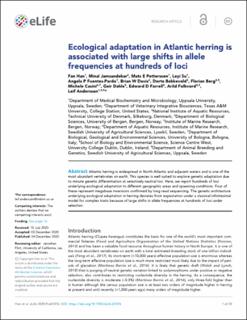Ecological adaptation in Atlantic herring is associated with large shifts in allele frequencies at hundreds of loci
Han, Fan; Jamsandekar, Minal; Pettersson, Mats; Su, Leyi; Fuentes-Pardo, Angela P.; Davis, Brian W.; Bekkevold, Dorte; Berg, Florian; Casini, Michele; Dahle, Geir; Farrell, Edward D.; Folkvord, Arild; Andersson, Leif
Journal article, Peer reviewed
Published version

View/
Date
2020Metadata
Show full item recordCollections
- Department of Biological Sciences [2290]
- Registrations from Cristin [10412]
Abstract
Atlantic herring is widespread in North Atlantic and adjacent waters and is one of the most abundant vertebrates on earth. This species is well suited to explore genetic adaptation due to minute genetic differentiation at selectively neutral loci. Here, we report hundreds of loci underlying ecological adaptation to different geographic areas and spawning conditions. Four of these represent megabase inversions confirmed by long read sequencing. The genetic architecture underlying ecological adaptation in herring deviates from expectation under a classical infinitesimal model for complex traits because of large shifts in allele frequencies at hundreds of loci under selection.
